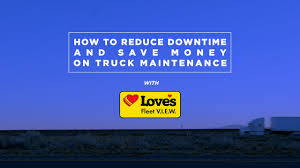
As everyone in trucking and the supply chain is aware, everything breaks down eventually. Tracking the status of maintenance intervals and ongoing repairs is a vital practice for any fleet, and that’s why fleet managers need to leverage modern tools to stay informed.
FreightWaves’ Thomas Wasson sat down with Justin Brevik, senior manager of fleet maintenance and service at Love’s Travel Stops, to talk about how Love’s Fleet V.I.E.W. is built to streamline asset management.
Brevik spent his early career on the frontlines of maintenance as a technician, driver and maintenance manager, and as a result he has intimate knowledge of what technicians and fleet managers need in order to keep fleets moving efficiently.
Every day an asset or a driver is down for repairs or maintenance is a day that the fleet isn’t earning, but thankfully, adequate visibility and planning can keep downtime to a minimum.
“Maintenance is one of the highest expenses in a trucking company but by far the most controllable,” Brevik said.
One common denominator that Brevik encountered when speaking to fleets was that most of them were using outdated software or had minimal information about asset status.
“With Love’s Fleet V.I.E.W, we’ve been very successful helping our customers be more efficient in understanding the health of their fleet at their fingertips so they can make better business decisions,” Brevik said.
According to Brevik, Love’s Fleet V.I.E.W. is a fully modern and mobile asset management, maintenance, breakdown management, shop inventory and technician management platform with best-in-class analytics.
The Love’s Fleet V.I.E.W. platform is a cloud-based system that allows fleets to better manage maintenance needs on the web or on-the-go through a new app.
Love’s Fleet V.I.E.W. gives fleets an integrated and intuitive repair and maintenance process, a simplified parts and inventory management method, an easier way to use warranties and customized analytics for visibility and workflow.
“We offer unlimited users and unlimited storage space, and with the many integrations we have to various platforms and Transformation Management Systems (TMS), it really helps with communication between shops, vendors, and fleets,” Brevik said.
To function across these disparate platforms that various technicians and carriers might be using, Love’s Fleet V.I.E.W. uses open APIs and webhook capabilities.
“A lot of our customers leverage those APIs to pull the data into their TMSs or accounting systems, but we also have structured integrations with companies like McLeod, QuickBooks, Goodyear, Travel Centers of America, and of course Love’s,” Brevik said.
For managers of small fleets, open APIs like this make integrations much easier than manually entering and tracking data on spreadsheets, but of course large carriers benefit as well.
“We have fleets ranging from twenty-five trucks to eleven thousand,” Brevik said. “Anywhere in between, the system doesn’t change speed based on the amount of assets you have. It’s a fast, reactive program.”
With AI and deep-learning technology reaching the mainstream, maintenance is perhaps one of the most useful fields that can utilize predictive analytics.
“We launched our first suite of AI-driven products back in November [of 2024], with the first being AI invoice import,” Brevik said. “That tool reads any invoice from any vendor, pulls it into the system, breaks out info by VMRS [Vehicle Maintenance Reporting Standards] code, and helps you file information with the correct accounting.”
Fleet V.I.E.W. also includes AI help features for technicians. If the technician hasn’t done a repair on a certain vehicle, the system will provide step-by-step instructions for each part of the process.
“Our AI analytics are also incredibly useful,” Brevik said. “Instead of building a report in your maintenance software, you can simply ask the AI which trucks are costing the most in breakdowns, for instance, and build charts with that data.”
According to Brevik, the future of fleet management is AI. “We’re working on tools to help give more refined answers on how long a vehicle is going to be down or even how long until it will need a repair,” he said. “In some cases, we’ll be able to tell you ‘Hey, you have four days to fix this issue or you’ll be stuck on the side of the road,’ or in contrast, you might have four months and can make a more strategic decision about when and where to perform your maintenance and repairs.”
Knowing how much fault codes are going to cost and when they’re likely going to arise helps fleet managers plan on those events in advance.
Traditionally, fleet managers and drivers have had to manually communicate with shops and technicians to track the status of their assets, which can make it difficult to plan on when and where to work. Love’s Fleet V.I.E.W. takes visibility to an entirely new level. Managers can make much more tactical decisions, even comparing how much more quickly parts from certain vendors are wearing down and what kind of costs are avoidable.
“One of the reports we’re most excited about is our analysis of tire miles by brand,” Brevik said.
Many carriers either buy the cheapest options or sometimes whatever they have access to, but by having data on how long particular tires will last and being able to map out costs over a longer period of time, fleets can make much more informed decisions about which tires to purchase.
“Tires are your most expensive regular maintenance expense, so you really need good data on them,” Brevik said. “You might find that one brand of tires costs slightly more but lasts twice as long, and that type of info can make a huge impact on running your fleet efficiently.”
Warranties are another element of fleet management that are often neglected, and many fleets don’t feel like it’s worth it to chase down warranty dollars.
“I can tell you that the fleets that are recouping warranty costs are not as concerned about freight rates as the fleets who aren’t chasing warranty dollars,” Brevik said.
Love’s Fleet V.I.E.W. offers one of the only platforms on the market with real-time warranty notification. Most software, if it notifies the user at all, will only notify them after a repair order is closed.
“We’re notifying the user in real time,” Brevik said. “We can bulk upload all of your available warranties into the system, and so if you have a repair on any of those parts you’ll be notified in real time that it’s under warranty.”
A lot of fleets will buy a new part and forget about it months later when it fails and simply buy a new one at that time. The Love’s Fleet V.I.E.W system notifies fleets about any warranties and gives users a hyperlink back to the previous repair order to make it easy to file a claim with that vendor. The fleets that follow that practice, according to Brevik, are recouping large amounts of money.
Vendor optimization, likewise, is one of the key differentiators for Love’s Fleet V.I.E.W.
For most fleets, a driver with a breakdown calls their support, who then records the information and tries to find a vendor.
“We’re integrated with all major telematics providers,” Brevik said. “When the user creates a repair order, we automatically ping the telematics device in real time and pull up a map of all the nearest vendors. In our gap analysis, the traditional way takes thirty to forty minutes to find a vendor, but we can find one in twenty to forty seconds,” he said.
Over the course of a year, that’s a substantial reduction in downtime.
“Our platform also allows you to rate vendors,” Brevik said. “You can designate preferred vendors, secondary choices, or most importantly, a ‘do not use’ vendor. It happens a lot that you have a bad experience with a shop and don’t report that to your whole company, and months later another driver uses them again.”
To help users learn how to properly utilize Fleet VIEW, Love’s also offers best-in-class customer support.
“The help section in our platform is very robust,” Brevik said. “You start typing you need help with, and it will instantly direct you to help. Same day support and ninety-nine percent same day resolution.”



